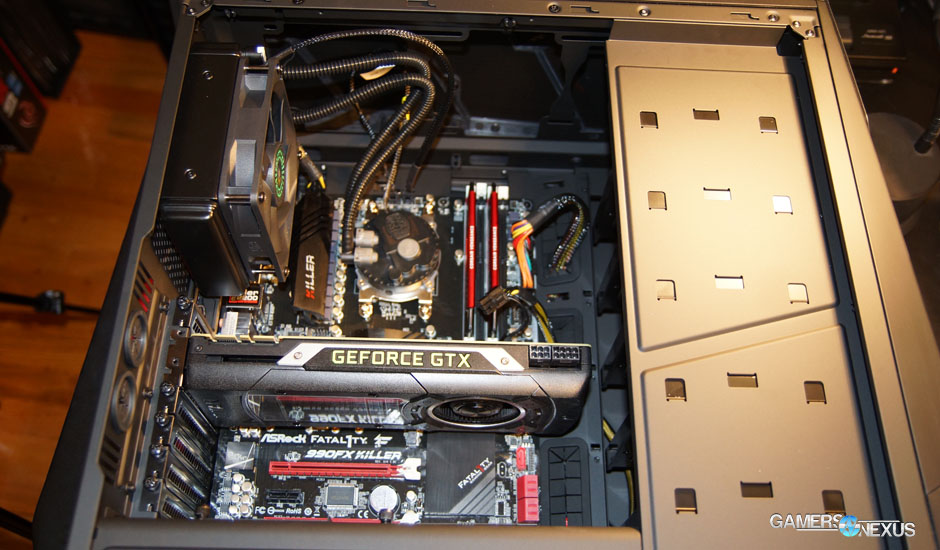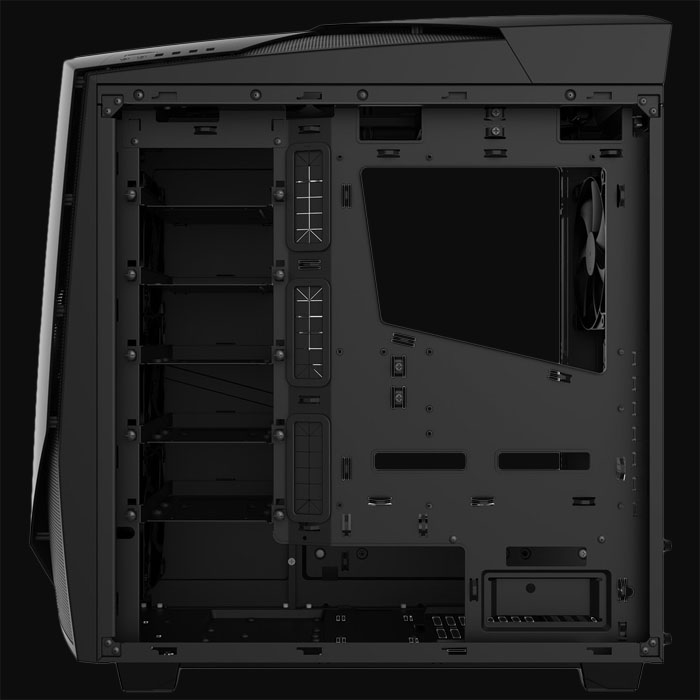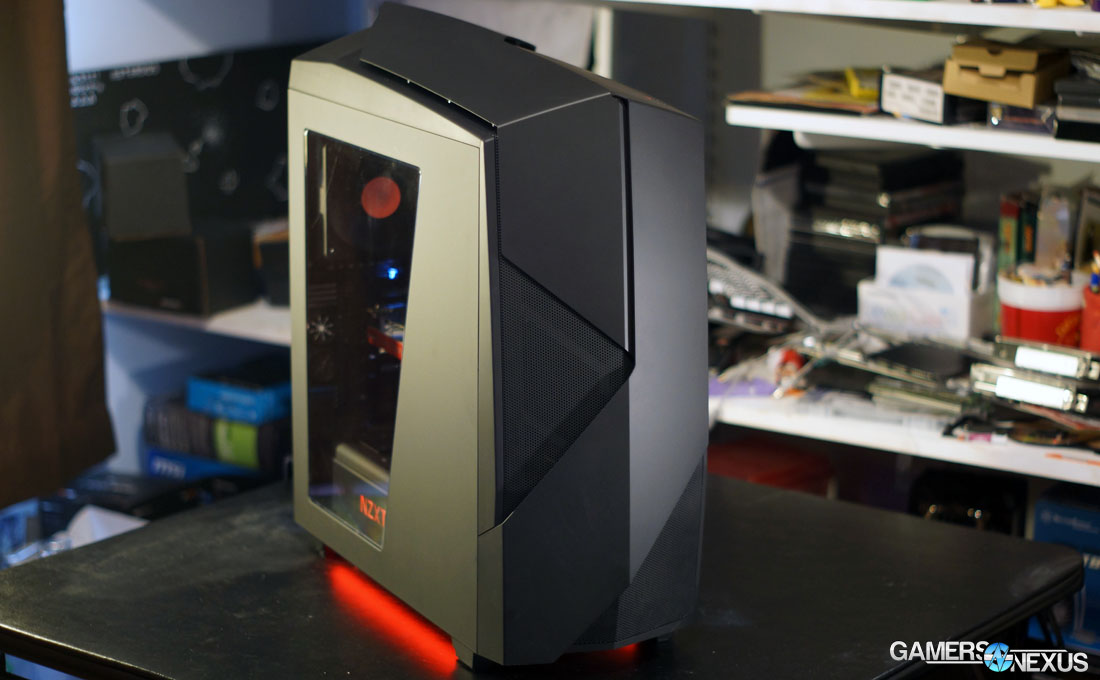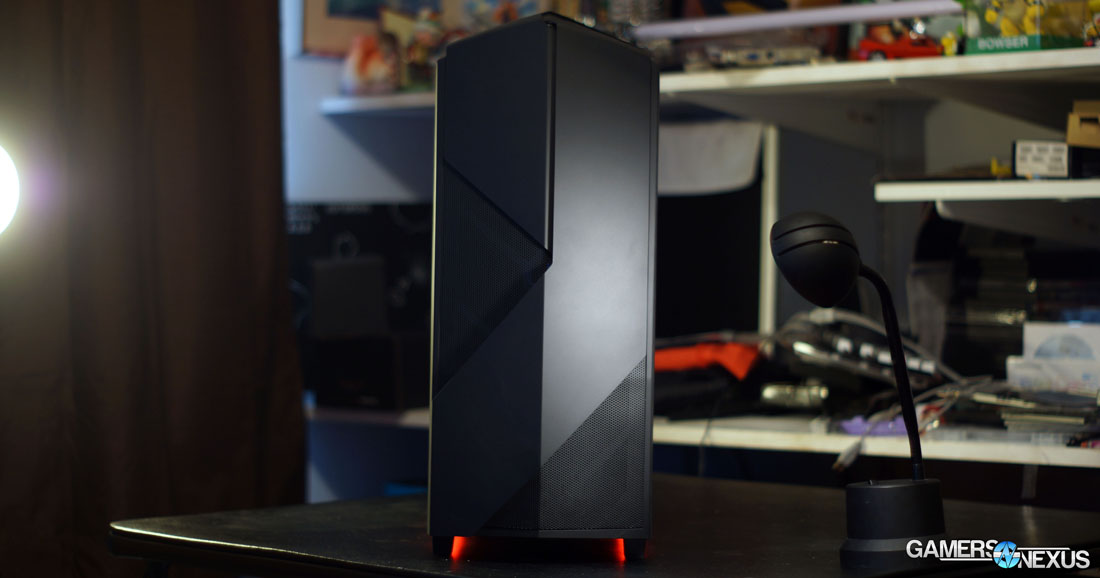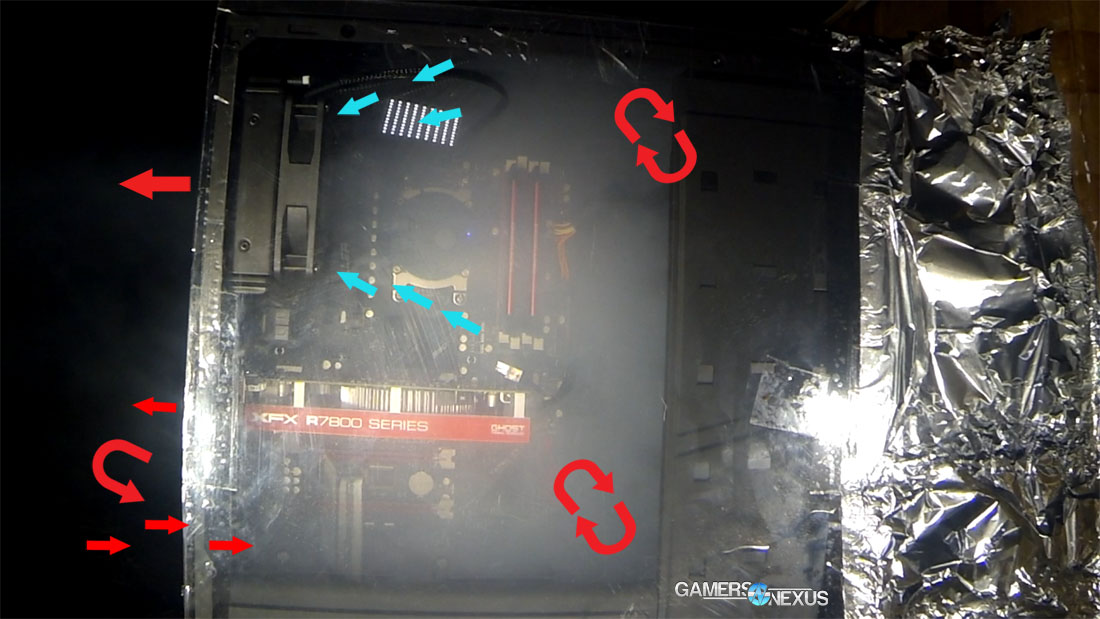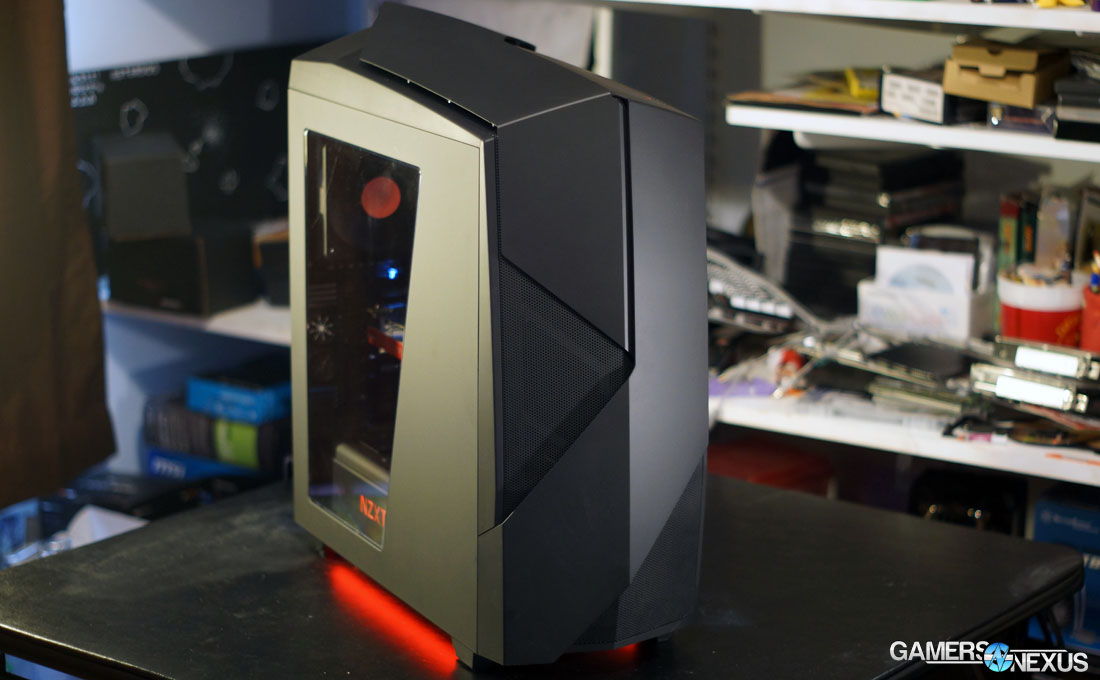NZXT has come a long way. For a company that at one time made some of the most... “interesting” cases on the market, we've transitioned from cautioned observance to ranking recent enclosures among the likes of Corsair. The launch of the H440 ($120) proved that NZXT can design something discreet and functional without venturing into the “gamer” aesthetic that they've historically occupied. Alongside the H440, NZXT's S340 – a case I actually like better, although it's cheaper – and Phantom 530 have fronted a redoubled effort to capitalize on the market's demands for stout, robust build quality.
The Noctis 450 ($140) combines properties of the Phantom- and H-series lineups, something we recently discussed with former NZXT case designer Chung Tai. Today, we're reviewing the build quality, installation, cable management, and airflow of the NZXT Noctis 450 (N450) case.
NZXT Noctis 450 Video Hands-On & Airflow Smoke Test
NZXT Noctis 450 Specs
| Model Number | CA-N450W-M1 (Matte Black and Red LED Accents) |
| Drive Bays | External 5.25": 0 Internal 3.5"/2.5": 6+2 |
| Cooling System | Front: 2x 140/3x120mm (3 x 120mm FN V2 Fans Included) Top: 2x 140/3x120mm Rear: 1x 140/120mm (1 x 140mm FN V2 Fan Included) |
| Filters | Front (Included) Bottom Rear(Included) |
| Radiator Support | Front 2 x 140 or 3 x 120mm Top 2 x 140 or 3 x 120mm Rear 1 x 140/120mm |
| Clearance | GPU Clearance With HDD Cage: 294mm GPU Clearance Without HDD Cage: 406.2mm CPU Cooler: 180mm Cable Management: Lowest Point - 17.7mm; Highest Point 32.5mm |
| Dimensions | 220mm x 567mm x 544mm (WxHxD) |
| Material | SECC Steel, ABS Plastic |
| Motherboard Support | Mini-ITX, MicroATX, ATX |
| Expansion Slots | 7 |
| External Electronics | 1 x Audio/Mic I/O Panel LED On/Off |
| Product Weight | 9.75 kg |
| UPC | 815671012418 (Black/Red) |
| EAN | 5060301692705 (Black/Red) |
| USB 3.0 Ports | 2 |
| USB 2.0 Ports | 2 |
| Warranty | 2 Years |
NZXT has issued the H440 interior for a repeat deployment in the N450, making effectively zero changes to the chassis that has gained grip in the enclosure market. Fans of the H440 will be inherently pleased with the N450 chassis and interior. The N450 ships for $140, a $20 bump over the H440.
Among major items to note, the N450's fan spec sees the inclusion of 3x120mm front fans (intake) and a single 1x140mm rear exhaust fan. Mount points exist in the top of the case for 2x140 or 3x120mm fans, which can be exchanged for a number of radiator sizes, including 240, 280, and 360mm units. The top panel allows radiators of ~25mm in the compartmentalized over-chassis chamber; fans accompanying the radiators would need to be mounted internally.
As with previous iterations of the chassis, the N450 adheres to NZXT's decision to abandon 5.25” drive bays in some enclosures. This dismissal of space-consuming bays allows a few important items for the N450: The faceplate design and the use of shrouded hard drive slots.
The faceplate, as we learned from NZXT's N450 designer, uses interwoven, thin sheets of plastic to create an almost X-Men-like appearance. The sheets hover over the large intake mesh and cross paths, something that wouldn't be possible with a front-facing 5.25” bay.
Regarding the aesthetic, the Noctis 450 plays the part of the Phantom, but does so with less offensively plastic-intensive paneling. It's still a lot of plastic – and the look is still very “gamer” – but, in the least, it at least pretends to be artistic in its implementation.
NZXT Noctis 450 Installation
Installation is trivial, if annoying at times.
We've had a long history of complaints with very small, seemingly-minor complaints on NZXT's enclosures. The big picture obfuscates some of these details and makes them inconsequential after the system has been built (and, really, most users only build it once), but we list them because we want to see improvement.
The first step of system building is to remove the panel screws, and with the H440/N450/S340, the PSU mount screws also must be removed. NZXT uses thumbscrews in all of these locations, theoretically allowing for a tool-less exterior. The same goes for the expansion card slots, all of which rely on thumbscrews for VGA mounting. Unfortunately, the screws are over-torqued to the extent that they require some strength behind a screwdriver to remove. Once we've reached that point, the case may as well use normal screws instead. We also ran into this problem with one of the standoffs, something that was complained about in our S340 review by Patrick Lathan.
It's a small issue, but it should be fixed. Novice builders need all the help they can get to avoid inadvertently stripping a component in the mad fervor to build a new PC. NZXT is aware of the matter and tells us that retail samples should be easier to work with.
Larger top-mounted radiators, like Antec's 1250, will understandably not be able to make use of NZXT's compartmentalized space above the steel. This isn't something we necessarily knock NZXT for, but users should be aware that it's best to buy an Asetek-supplied CLC for use in the N450. Even using the Seidon, which underwent a legal thrashing by Asetek, seems to have mounting issues in the top of the N450. The Asetek-compliance makes sense, given NZXT's current lineup of CLCs (the Kraken X41 and X61 are both Asetek devices). The instant a push-configured cooler has to be mounted under the steel, it's possible that you'll run into issues with the radiator/fan impeding access to the EPS12V connector.
For the most part, installation is trivial. Mount the motherboard, PSU, video card, and a hard drive or SSDs, and then move on. With respect to the hard drive mount, we're big fans of the under-side cage (also found on the S340) and think that it's a clever solution for hiding away a 3.5” drive. NZXT gets our approval on this solution.
NZXT Noctis 450 Build Quality & Cable Management
The N450 is an H440 incarnate, and inherits its traits for high interior build quality. The paneling is sturdy and accommodating, allowing effectively all reasonable CPU coolers (180mm max) and AICs (294mm to 406.2mm without cages) to fit.
We noticed that NZXT included multiple cable pass-throughs for EPS12V connectors, something that's sorely lacking in other cases; this ensures that motherboards with more left- or right-aligned CPU power headers can be routed through the rear of the enclosure. Pass-throughs in the PSU shroud supply direct access to most IO panel headers (though not all – some boards will require routing through the center channel) and direct access to the video card (AIC) header.
Rear cable tie points offer aligned channels, assisting in making the “ugly side” of the case less ugly without investing tremendous time.
This is all the same as what we said about the H440.
As for the paneling – the truly new aspect to the N450 – we immediately noticed the ease with which the top and front panels are removed. Because the top panel I/O is not physically attached or electrically wired to the panel itself, the top and front of the case can be completely removed without a tether. The paneling uses a somewhat hardy plastic and employs a matte finish for a higher quality appearance (we complained about the Phantom 530's “plasticky” appearance, amplified by the gloss finish).
This matte paint also tarnishes easily. Running a fingernail along the surface leaves behind a trail of white marks; it's easy to remove the marks by brushing the surface with a palm, but the ease with which it is marred causes concern. In the process of unboxing and installing the enclosure, we managed to incur a somewhat deep scratch in the surface of the paint that's now permanent. We're not sure what type of paint is used in the N450, but whatever it is, it's not strong -- our white H440 did not exhibit these issues, for reference, and feels substantially more resilient. NZXT is big on the look and feel of the paint – and they should be, because both aspects excel – but it's just not strong enough. Users should anticipate some form of permanent marks or scratches within the lifetime of the case, based on our experience.
It's worth making a final note of the fan hub. NZXT's fan hub forwards the CPU's PWM signal to the attached fans, allowing the motherboard and CPU to control the fan speed of all hub-attached fans. This type of hub has been used in cases we've previously reviewed, but the N450 uses a more advanced unit that offers OV and other protections, something we don't find much outside of third-party add-ins.
NZXT N450 Aesthetics & Lighting
A big feature with the N450 is its underglow “neons,” feeling similar to what might be found in an import racer car. The underglow uses an LED strip (see: H440 Razer) on the long sides of the case, with additional lighting added to the PSU shroud logo and rear I/O panel. A toggle switch on the back of the case can disable all lights or enable each light individually. The underglow and disbursement of light is generally satisfying, if that's “a thing” for you.
NZXT shows attention to detail with its black PCBs on the rear of the case; the fan hub PCB and LED controller are both matte black, a minor detail that we readily criticize if overlooked.
The PSU and HDD cage shrouds are welcomed and encouraged; we've seen more manufacturers priming to shroud the PSU in cases (and some already have, if in a somewhat haphazard fashion), which lends support to the concept. The PSU shroud on NZXT's cases does not allow for upside-down installation, a big plus for making the lives of new builders a little less intimidating.
Enough mincing words: The exterior is what everyone cares about. As a website that prides itself on objectivity, we prefer to present data and images and allow readers to formulate their own opinions on appearances. That's not something we can do with cases.
I think I like the N450's look. My opinions have changed sharply over the life of GamersNexus – I once loved the Phantom 820, for instance, but we had a nasty separation. Papers were involved, and it sits neglected and dust-covered, broken, in a corner. The 820 just feels too big, bulky, heavy, bloated with plastic, and exhibited more than one fan explosion (the blades blasted apart – no, really). Lately, I've been a fan of simpler designs. The H440 is one of them, but it's almost too simple – there's not enough contrast in the design. This leads me to enclosures like the 760T, which is presently my favorite case on the market.
My preferences known, I find the N450 to offer a subdued, mid-step look between the aggressive “gamer” and discreet enclosures. The matte black keeps the angles and features a little more hidden unless looking directly at the case. The sharp angles remind me of older Alienware enclosures, all the way down to the extruded polygon at the rear of the top panel.
The initial renders of the N450 really don't do it justice. Using interwoven panels lends a unique and interesting elegance to an otherwise clear attempt at being "bold." To my knowledge, outside of premiere cases like In-Win's lineup, this design approach hasn't been attempted with great success.
Smoke Testing – A New GamersNexus Experiment
This is something new that we're developing. It's not fully scientific yet and we haven't laid-out a complete, step-by-step methodology. To this end, this information should be taken more as the musings of an eccentric case tester and less as scientific fact. We thought it'd be fun to share, but want to make known that the test is by no means final in its methodology or implementation. “Experiment” seems the right word.
I built a smoke chamber and employed smoke pellets (and fire) to feed sitting smoke into the front of the chassis, which was then recorded at native 120FPS with a GoPro camera (and native 60FPS with our Canon XA20). We took this footage and slowed it down to 50% speed to review smoke patterns in the case.
The result is best highlighted in our accompanying video at the top of the page.
- Smoke is used as a visual stand-in for air. A few points of note include the following:
- Smoke was rocketed out the back of the case (through the rear-mounted radiator) at high speeds.
- Smoke converged on the rear radiator toward the top-back fan mount. This reinforces our previous findings that the front-most top fan position – if adding another fan – is far-and-away preferable to the back-rear position. The rear position suffocates the natural pull of the rear exhaust fan, raising CPU temperatures in some of our tests. The smoke test illustrates this.
- Smoke pooled in the drive cages due to limited exhaust potential.
- Smoke pooled below the VGA. This reinforces our findings that, almost without exception, a side-mounted fan is the most effective way to cool a video card. Air just gets trapped otherwise.
- Smoke got caught in the top-front corner of the enclosure, creating a vortex of hot air. Fortunately, no components dwell in this region, so this is inconsequential.
- Smoke exhausted out the back of the case (near the VGA) started getting sucked back into the case as components heated up and air saturated the cooling units. This caused a drafting effect where air would sort of waft between the outside and inside of the case near the VGA.
- Humans shouldn't inhale large amounts of smoke.
We're not sure if we'll do this again in the future. We've tested smoke on the Raven RV02, which uses stack effect cooling, and the KL04. It's probable that our smoke tests will only be employed on uniquely cooled cases going forward (like the RV02) to best illustrate the function of non-standard cooling.
NZXT N450 Verdict
NZXT's N450 has a few shortcomings and, sadly, most of them are not new to NZXT's cases. The screws and standoffs have torque issues that make for annoying installation, heat pools toward the bottom of the case around the video card, and (a new issue, in our experience) although the paint is a nice thought, it scars too easily.
The upsides are equally prevalent: The design is unique and will appeal to some users, it's well-executed mechanically (interwoven plastic plates are non-trivial to manufacture with strength), and the cooling is improved over the H440. This isn't a “quiet case,” as evidenced by the introduction of meshing wherever space allows, and shouldn't be treated to the same expectations as quieter enclosures. It's entirely meant for an audience that wants a visually "loud" case.
Build quality of the chassis is exceptional, as is the structure of the paneling, but the paint and screws need improvement.
If you're looking for some sort of not-quite-Phantom, not-quite-discreet enclosure, the N450 is worth strong consideration.
- Steve “Lelldorianx” Burke.
